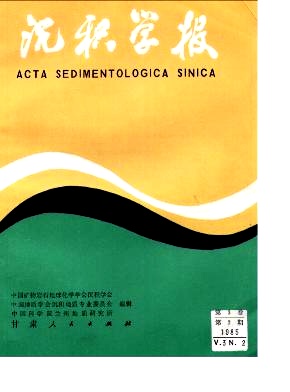APPROACH ON DEPOSITION ENVIRONMENT AND FOR- MATION PROCESSES OF EARLY JURASSIC IRONSTONE IN EASTERN SICHUAN AND ITS ADJOINING AREA
- Received Date: 1983-09-12
- Publish Date: 1985-06-10
Abstract: The ironstone is gray, dark purple micriti, intraclast siderite with an interla-yer of purple intraclast hematite of 1-5.5m thick. It is found on the quartzose sandstone and coal bed of river and lake-shore facies in lower Jurassic, it is 2-10m thick. Its roof is lacustrine sandstone and shale, being 2-15m thick.This stratigra-phic section is called Qijiang segment, it is distributed at Chongqing, Qijiang, Shizhu and Lichuan, etc. The industrial deposit is accumulated in the south and north of Qijiang ( Figure 1,3). Without exception the ironstones are all accumulated over the peat-swamp deposits that include coal-bed and carbonaceous shale ( Figures,6 ) . Terefore, there is no ironstone accumulated over the sediments of river-lake-shore and argillaceous swamp of the adjoining area. The underlying strata of Qijiang segment are late Triassic yellow medium-fine grained feldspathic quartzite sandstone with an interlayer of little claystone and coalbed, its thickness is between 200 and 600m. During ironstone deposition, the old-land of Proterozoic metamorphic rock was exposed in the southeast area, the half-deep water lake occured in the north area and between these two areas there was river-lake-shore plain on which were distributed some peat-swamps. After the peat was formed, the cover water of these swamps was slightly deepened. As the water medium was reduced by base peat,Eh of the pore water in the lower peat-bed was Omv± and it rose to 400-600mv on the upper limnetic water,thus forming the vertical-divided zone of oxidation-reduction of limnetic water. When pH ( or pH value ) of the peat-limnetic water generally 5 to 6, the oxidation-reduction boundary of the ferri-oxide-ferri-carbonate was between 150 and 280mv (figure 8 ). The ferri-rock of old-landformed Fe(HCO3)2 with greater solubility under the action of organism. Fe ( HCO3 ) 2 came into half-solid sediments of late Trias and was transported toward north in phreatic form. The ferri-ground water in fused peat limnetic. The difficultly solvable Fe(OH)3 was formed and deposited in micriinite by oxidization of oxygen and ferri-germ when Fe2+reached above the ferri oxidation-reduction boundary. Then siderite-micrite ironstone was formed by the reduct-replacement of limnetic base medium. With the thickening of accumulation of ferri sediments, the reductive ability of base medium was weakened and therefore, hematite micrite ironstone was formed. The intrusion of river water or the wave action produced intraclast-ironstone. The roof and floor of some ironstone are generally accompanied by redox-rock both at home and abroad and it seems that the mechanism of formation is the same. This paper shows the prospect direction of this kind of iron ore and presents some new ideas about the origin of ironstone.
| Citation: | Xu Xingguo. APPROACH ON DEPOSITION ENVIRONMENT AND FOR- MATION PROCESSES OF EARLY JURASSIC IRONSTONE IN EASTERN SICHUAN AND ITS ADJOINING AREA[J]. Acta Sedimentologica Sinica, 1985, 3(2): 119-128. |






 DownLoad:
DownLoad: